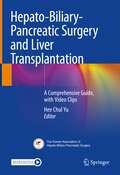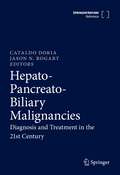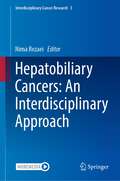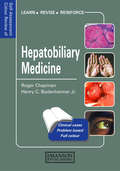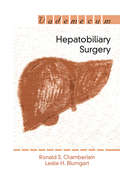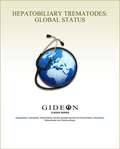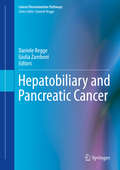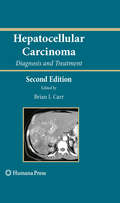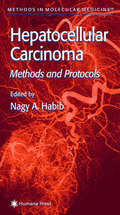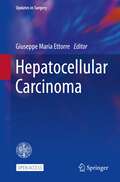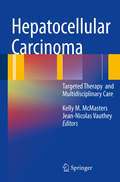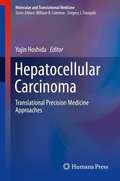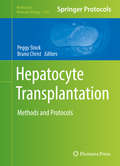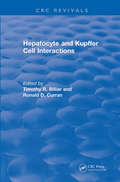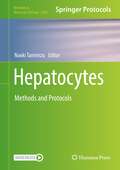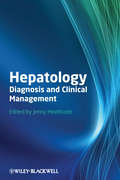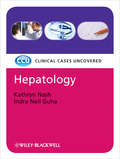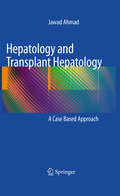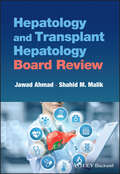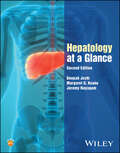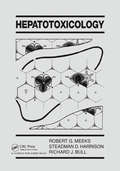- Table View
- List View
Hepato-Biliary-Pancreatic Surgery and Liver Transplantation: A Comprehensive Guide, with Video Clips
by Hee Chul YuThis book describes and illustrates surgical procedures in the field of hepatobiliary and pancreatic surgery and liver transplantation, including important cutting-edge techniques. Written by master surgeons from the Korean Association of Hepato-Biliary-Pancreatic Surgery, it will be invaluable for all who are embarking on a career in this field or are seeking to improve their surgical skills. The three sections of the book focus on liver surgery, gallbladder and biliary surgery, and pancreatic surgery. A wide range of operative procedures are covered, including different techniques of hepatectomy, deceased and living donor liver transplantation, cholecystectomy, resection of choledochal cysts, procedures appropriate in the contexts of hilar and extrahepatic cholangiocarcinoma, pancreatectomy, and pancreaticoduodenectomy. Attention is drawn to essential tips and tricks, and each chapter includes video clips of the described procedures in addition to high-quality surgical photos and illustrations.
Hepato-Pancreato-Biliary Malignancies: Diagnosis and Treatment in the 21st Century
by Cataldo Doria Jason N. RogartHepato-Pancreato-Biliary cancers are increasing in incidence, with pancreatic cancer now accounting for the third most cancer deaths in the United States. Typically these malignancies, as a group, are managed by the same key providers comprising a multidisciplinary team. This book is intended to provide a comprehensive review of the current knowledge in the field of hepato-pancreato-biliary malignancies, focusing on the practical and clinical care of patients. We take the approach of combining the collective expertise of an interventional gastroenterologist and a hepato-pancreato-biliary surgeon to provide the readers with accurate, succinct, and pragmatic information needed to formulate the most appropriate treatment plan for their patients with the aim of the best possible outcome. Managing patients with these cancers continues to be challenging because of continued dismal survival rates. Each section in this text is written by experts in their respective field, summarizing the most state-of-the-art, contemporary diagnostic and therapeutic tools available in the field. We believe this book will prove to be an invaluable, comprehensive resource for all members of the multidisciplinary team caring for patients with hepato-pancreato-biliary malignancies.
Hepatobiliary Cancers: An Interdisciplinary Approach (Interdisciplinary Cancer Research #3)
by Nima RezaeiHepatobiliary cancers, including hepatocellular carcinoma and biliary tract cancers, have high rate of mortality and low survival rate. The third volume of the “Interdisciplinary Cancer Research” series, entitled “Hepatobiliary Cancers: An Interdisciplinary Approach” publishes comprehensive volumes on mechanisms of hepatobiliary cancers and therapeutic modalities and presents the most updated and peer-reviewed chapters on hepatobiliary cancers. This interdisciplinary series is of special value to researchers working on cell biology, immunology, biochemistry, genetics, and practitioners working on oncology and gastroenterology. This is the main concept of Cancer Immunology Project (CIP), which is a part of Universal Scientific Education and Research Network (USERN). This interdisciplinary book will be of special value for researchers, oncologists, and gastroenterologists who wish to extend their knowledge on hepatobiliary cancers.
Hepatobiliary Medicine (Medical Self-Assessment Color Review Series)
by Roger Chapman Henry Bodenheimer Jr.Hepatobiliary medicine has seen major recent scientific advances in viral hepatitis, haemochromatosis, and autoimmune liver/disease. This has been aided by imaging advances in MRI and CT. This volume of 200 cases, written by an internationally renowned author team, covers the whole spectrum of liver disease. The text entries are supplemented with c
Hepatobiliary Surgery
by Ronald S. ChamberlainThis book is written as a reference and guidebook for practicing surgeons, gastroenterologists, and interventional radiologists with an interest in hepatobiliary diseases. It presents a strategy to enhance surgeons practice and the care of patients.
Hepatobiliary Trematodes: Global Status 2010 edition
by Dr Stephen Berger Gideon InformaticsHepatobiliary Trematodes: Global Status is one in a series of GIDEON ebooks which summarize the status of individual infectious diseases, in every country of the world. Data are based on the GIDEON database (www.gideononline.com) which relies on standard text books, peer-review journals, Health Ministry reports and ProMED, supplemented by an ongoing search of the medical literature. Chapters are arranged alphabetically, by country name. Each section is divided into five subsections. 1. Descriptive epidemiology 2. Summary of clinical features 3. Global status of the disease 4. Status of the disease in a specific country 5. References Hepatobiliary Trematodes: Global Status includes separate sections on Clonorchiasis, Fascioliasis, Metorchiasis, and Opisthorchiasis.
Hepatobiliary and Pancreatic Cancer (Cancer Dissemination Pathways Ser.)
by Giulia Zamboni Daniele ReggeThis book describes the pathways of dissemination of primary liver, biliary, and pancreatic neoplasms and proposes a practical and clinically driven approach to their imaging. The typical dissemination pathways for hepatocellular carcinoma, cholangiocarcinoma, exocrine pancreatic carcinoma, and neuroendocrine pancreatic tumors are systematically reviewed, and more unusual pathways are also documented. The content is presented in an extremely schematic way, with numerous high-quality graphical illustrations and multimodality images (US, CT, MRI, and PET) that are accompanied by clear explanatory text. The clinical significance of findings and potential therapeutic options are explained whenever appropriate. In addition, relevant background information is provided on the role of morphopathological drivers of cancer spread and anatomy.
Hepatocellular Carcinoma
by Brian I. CarrHepatocellular cancer is the fifth most common cancer, with 600,000 new cases reported each year worldwide. Additionally, exciting changes in the science of HCC in the last four years have turned the practice of diagnosing and treating the disease upside down. In Hepatocellular Carcinoma: Diagnosis and Treatment, Second Edition, the leading experts in the field of HCC thoroughly update and expand upon the critically acclaimed first edition with all the latest developments in the diagnosis and treatment of primary liver cancer. The book details for physicians the diagnostic and therapeutic decision making process for dealing with such problems as incidental tumors in the liver transplant, the role of neo-adjuvant chemotherapy, intra-arterial vs intravenous therapy, the uses of embolization, and the significance of portal vein thrombus. New chapters discuss the introduction into clinical practice of cell cycle growth inhibitors, an expanded knowledge of Genomics and Proteomics, and novel ways of delivering intra-hepatic chemotherapy. This cutting-edge text is a vital resource and must have for today's hepatologists and medical and surgical oncologists.
Hepatocellular Carcinoma
by Brian I. Carr* Hepatocellular carcinoma (HCC) used to be regarded as a rare disease. However, the increasing numbers of chronic HCC carriers in the U. S. and subsequent increased incidences of HCC seen in most large medical centers means that it is no longer an uncommon disease for gastroenterologists or oncologists to encounter and its incidence and epidemiology are changing. During this exciting time in the field of HCC basic science and clinical management, many changes are simultaneously occurring at multiple levels of our understanding and management of the disease. Suddenly, there are several new choices of therapy to offer patients. Hepatocellular Carcinoma, 3rd edition addresses this fast-changing disease and gives the reader a clearer understanding of the many mechanisms involved in carcinogenesis of the liver. This comprehensive and detailed review of how to diagnose and treat hepatocellular carcinoma is written by international leaders in the field, covering both clinical treatment choices and the basic science underlying HCC development. Updated and enhanced from the last edition in 2009, Hepatocellular Carcinoma, 3rd edition features 12 new chapters including discussion of molecular markers, molecular hepatocarcinogenesis, microenvironment, heterogeneity, the new and exciting contributions of immunotherapy, and updates on the major effective hepatitis therapies that will transform HCC indidence and perhaps also the therapy. This cutting-edge text is a vital resource and must-have for today's hepatologists and medical and surgical oncologists. "This is a well written text and should be a good reference book for those who see patients with HCC. . " - Practical Gastroenterology ". . . a useful tool for both physicians and surgeons with a specific interest in the management of patients with HCC. " - Digestive and Liver Disease
Hepatocellular Carcinoma
by Rajagopal N. Aravalli Clifford J. SteerThis book provides up-to-date information on the development and progression of hepatocellular carcinoma (HCC) with a review of the cellular and molecular mechanisms involved in the disease process. Recent research in HCC has led to significant progress in our understanding of the cellular processes and molecular mechanisms that occur during multi-stage events that lead to hepatocarcinogenesis. The emergence of micro RNAs and molecular targeted therapies have added a new dimension in our efforts to combat this deadly disease, Chapters include discussion and evaluation of current intervention strategies and therapeutic options and a focus on the novel approaches that are being pursued, such as micro-RNA based therapies and personalized medicine to treat liver cancer. This book will be of interest to basic and clinical researchers, as well as to drug developers.
Hepatocellular Carcinoma
by Nagy A. HabibNagy Habib and a team of clinical laboratorians and physicians describe the wide variety of powerful new laboratory methods currently being used for investigating and treating hepatocellular carcinoma. The book focuses on gene therapy approaches, including the use of such vectors as lipids, such viruses as adenovirus and baculovirus, and virus detection assessment using electron microscopy. It provides preclinical and clinical data on the killing of cancer cells using tumor-suppressor genes, antisense compounds to growth factors, immunotherapy (remove gene), or virus-directed enzyme prodrug therapy. Hepatocellular Carcinoma: Methods and Protocols offers experimental and clinical researchers a rich source of both basic science and clinical information on today's optimal use of gene therapy to treat and manage patients suffering from hepatocellular carcinoma.
Hepatocellular Carcinoma (Updates in Surgery)
by Giuseppe Maria EttorreThis open access book offers a comprehensive review of hepatocellular carcinoma (HCC) with a particular focus on the pathobiology and clinical aspects of the disease, including diagnosis and treatment. HCC is becoming one of the most common causes of cancer-related death worldwide. It is the fifth most common malignancy in men and the ninth in women, with an estimated 500,000 to 1 million new cases annually around the world. Independent of its cause, cirrhosis is considered a major clinical and histopathological risk factor for HCC development. Five percent of all cirrhotic patients develop HCC every year. Diagnostic tools for HCC include blood tests, high-quality imaging studies and liver biopsy. The treatment of HCC depends on the size and location of the HCC and includes surgical resection, liver transplantation, endovascular approaches, percutaneous ablation, and medical treatments. The book is organized into four parts – overview, diagnosis, management strategies, and recommendations – and aims to provide surgeons and clinicians with a valuable resource for complete and up-to-date research on the clinical aspects and management of HCC.
Hepatocellular Carcinoma:
by Kelly M. McmastersHepatocellular Carcinoma: Targeted Therapy provides a detailed repository of the latest information regarding HCC epidemiology, diagnosis, imaging, pathology, staging, and treatment options. This volume also provides an up-to-date guide for treatment that explores not only traditional treatments, but newer investigational treatment options including, surgical resection, liver transplantation, ablation (radiofrequency, microwave), percutaneous ethanol or acetic acid injection, transarterial chemoembolization (TACE), intra-arterial radiation therapy, and systemic chemotherapy. Heptocellular Carcinoma: Targeted Therapy will be of great value to all health care professionals and trainees worldwide who have an interest in the diagnosis and treatment of HCC, including surgeons, medical oncologists, radiologists, radiation oncologists, and pathologists.
Hepatocellular Carcinoma: A Practical Approach
by K Rajender Reddy Luigi Bolondi Bandar Al KnawyAn essential resource for gastroenterologists, hepatologists, liver surgeons, hepatobiliary surgeons, oncologists, and all those working in the field of hepatocellular carcinoma (HCC), Hepatocellular Carcinoma: A Practical Approach covers the updates and recent developments on the diagnosis, screening, and comprehensive medical and surgical managem
Hepatocellular Carcinoma: Translational Precision Medicine Approaches (Molecular and Translational Medicine)
by Yujin HoshidaThis book provides a comprehensive overview of the current limitations and unmet needs in Hepatocellular Carcinoma (HCC) diagnosis, treatment, and prevention. It also provides newly emerging concepts, approaches, and technologies to address challenges. Topics covered include changing landscape of HCC etiologies in association with health disparities, framework of clinical management algorithm, new and experimental modalities of HCC diagnosis and prognostication, multidisciplinary treatment options including rapidly evolving molecular targeted therapies and immune therapies, multi-omics molecular characterization, and clinically relevant experimental models. The book is intended to assist collaboration between the diverse disciplines and facilitate forward and reverse translation between basic and clinical research by providing a comprehensive overview of relevant areas, covering epidemiological trend and population-level patient management strategies, new diagnostic and prognostic tools, recent advances in the standard care and novel therapeutic approaches, and new concepts in pathogenesis and experimental approaches and tools, by experts and opinion leaders in their respective fields. By thoroughly and concisely covering whole aspects of HCC care, Hepatocellular Carcinoma serves as a valuable reference for multidisciplinary readers, and promotes the development of personalized precision care strategies that lead to substantial improvement of disease burden and patient prognosis in HCC.
Hepatocyte Transplantation
by Bruno Christ Peggy StockThis volume features up-to-date protocols for the isolation, preservation, and validation of various cell sources comprising large and small animal models, examining the impact of cell transplantation on acute and chronic liver diseases. Hepatocyte Transplantation: Methods and Protocols guides readers through laboratory protocols for the generation of humanized livers for the assessment of biological actions in vivo and techniques to monitor cell engraftment after cell transplantation in vivo are described and procedures for computational analyses of hepatocyte transplantation. Written in the highly successful Methods in Molecular Biology series format, chapters include introductions to their respective topics, lists of the necessary materials and reagents, step-by-step, readily reproducible laboratory protocols, and tips on troubleshooting and avoiding known pitfalls. Comprehensive and practical, Hepatocyte Transplantation: Methods and Protocols is an essential resource for researchers and clinicians to assess the biological as well as the therapeutic potential of hepatocyte transplantation.
Hepatocyte and Kupffer Cell Interactions (CRC Press Revivals)
by Timothy R. Billiar Ronald D. CurranHepatocyte and Kupffer Cell Interactions presents a comprehensive discussion of historical and recent information regarding this diverse field of research. The role of Kupffer cells and hepatoctyes in normal physiology, nonseptic pathological states, and in sepsis is examined. Microanatomy and methods of experimental study are covered as well. In each of the book's chapters, the role of the Kupffer cell and hepatocyte interaction is placed in context with information on particular liver functions or disease states. Hepatocyte and Kupffer Cell Interactions is an essential reference for leukocyte specialists, gastroenterologists, immunologists, and other researchers working in this fascinating field.
Hepatocytes
by Patrick MaurelHepatocytes account for approximately 80% of the liver mass and play a significant role in various aspects of liver physiopathology, exhibiting unrivaled complexity and diversity of functions. In Hepatocytes: Methods and Protocols, expert researchers provide the reader with methods, technical protocols, and review chapters focusing on selected areas of hepatocyte biology including isolation, culture, differentiation and stem cells, and hepatocyte use in clinical, basic, and applied research. With a specific emphasis on human hepatocytes, the volume presents chapters covering subjects including hepatocyte culture models, cryopreservation methods, differentiation assessment, liver ontogenesis, production of hepatocytes from stem cells, drug/xenobiotic metabolism, toxicity and transport, bile acid and blood coagulation factor production, infection by HBV and HCV, humanized animals, biortificial liver devices, hepatocyte transplantation. As a volume in the highly successful Methods in Molecular BiologyTM series, protocol chapters include brief introductions to their respective topics, lists of the necessary materials and reagents, step-by-step, readily reproducible laboratory protocols, and notes on troubleshooting and avoiding known pitfalls. Comprehensive and cutting-edge, Hepatocytes: Methods and Protocols will be useful to all those who are currently using or planning to use human, or animal, hepatocytes to investigate any aspect of liver physiopathology or who are interested in liver development or liver stem cells and liver biotherapy.
Hepatocytes: Methods and Protocols (Methods in Molecular Biology #2544)
by Naoki TanimizuThis volume details experimental protocols to study structure and function of hepatocytes in vivo and in vitro, and for characterizing heterogeneity and plasticity of hepatocytes in healthy and in injured liver. Chapters guide readers through separating hepatocyte subfractions, characterizing the heterogeneity, novel culture systems, hepatocyte-like cells from human pluripotent stem cells, analyzing drug metabolism, monitoring protein sorting, manipulating gene expression, and methods for expanding primary hepatoblastoma and identifying hepatocellular carcinoma subtypes. Written in the format of the highly successful Methods in Molecular Biology series, each chapter includes an introduction to the topic, lists necessary materials and reagents, includes tips on troubleshooting and known pitfalls, and step-by-step, readily reproducible protocols. Authoritative and cutting-edge, Hepatocytes: Methods and Protocols aims to provide techniques to further understand molecular mechanisms involved in the regulating hepatocyte functions and underlying liver diseases.
Hepatology
by E. Jenny HeathcoteThis book will be an affordable, highly practical handbook on hepatology, aimed at residents/trainees in gastroenterology, GI nurses, and recently qualified consultants to use as a quick reference when managing patients presenting with possible or overt liver disease.It will be of particular use for those GI internists/residents who have an interest specifically in hepatology. It does not aim to be a specialist textbook, but a shorter, 250pp guide that provides key clinical information on each area of hepatology in an accessible form. Extracting relevant material from large reference textbooks can be very time consuming and for this reason, information in this handbook will be presented succinctly in a style suitable for quick reference and easy understanding.The chief emphasis will be on the clinical assessment and management of these patients, and all the major areas of liver disease will be covered, from liver cirrhosis to viral hepatitis, to autoimmune liver failure.Chapters will use a variety of structural features and colour coded boxes to increase the accessibility for residents. These include: key points/take-home points, case history, practice points and management algorithm/flow-charts. Each chapter will also contain sample multiple choice questions that the reader will be able to test themselves on.
Hepatology
by Kathryn Nash Indra Neil GuhaHepatology is an important specialty with diseases and complications related to viral hepatitis and alcohol being the main reason for seeking specialist advice. On most general medical rotations and on most surgical wards there are patients with hepatological problems. Hepatology: Clinical Cases Uncovered contains clinical presentations with real-life patient cases and outcomes as seen on the wards and in exams, and leads students through a practical approach to diagnosis and management of hepatological disease. Following a question and answer approach, including self-assessment material and a 'refresher' section on the basic science, Hepatology: Clinical Cases Uncovered features investigations and the treatment options available for patients presenting with hepatological problems. Difficult concepts are clarified and relevant links are made between pathology and clinical presentation. Hepatology: Clinical Cases Uncovered is ideal for medical students, junior doctors on the Foundation Programme, GP trainees, residents, specialist nurses and nurse practitioners. The book is also an ideal refresher for hepatology or gastroenterology trainees at the beginning of their specialist training programme
Hepatology and Transplant Hepatology
by Jawad AhmadHepatology and Transplant Hepatology: A Case Based Approach presents a collection of interesting cases in liver disease seen at a very busy and large liver transplant center in the United States. These cases cover the full range of pathology that an internist or gastroenterologist may expect to see in a lifetime of taking care of patients with acute or chronic liver disease, before or after liver transplant. Each case is presented as you would see it in a clinical situation where a patient presents a complaint or something is noted on exam or blood work. The question/answer format will help one through the problem of making a diagnosis or in considering a differential diagnosis and also point to the best way to manage each condition. The volume is divided into pre-transplant and post-transplant hepatology. Each case is 3 pages with the first page presenting the case and pertinent lab data and 3-4 questions (i.e. differential diagnosis, tests to order, x-rays/CT required).The second page illustrates the tests, scans, biopsies and asks for the pertinent findings. The third page provides the diagnosis and what may have been expected with other diagnoses. Here is a single source dealing with questions specific for patients with complications of advanced liver disease and also clinical situations seen in transplant hepatology. Hepatology and Transplant Hepatology: A Case Based Approach will have great appeal to anyone in hepatology/transplant hepatology and also to residents/fellows and internists interested in gastroenterology.
Hepatology and Transplant Hepatology Board Review
by Jawad Ahmad Shahid M. MalikHepatology and Transplant Hepatology Board Review Hepatology and Transplant Hepatology: Board Review with Multiple Choice Questions is the only source you will need to pass the American Board of Internal Medicine (ABIM) transplant hepatology examination. Written by two highly experienced hepatologists, this indispensable study guide covers all the main topics tested on the exam: pre-transplant, perioperative, post-transplant, and transplant immunology. 261 multiple-choice questions with answers, including questions based on the authors’ real-life cases, are designed to mimic the clinical scenarios you will encounter in hepatology practice. Questions testing your medical knowledge, clinical insight, and management skills are supported by brief topic overviews, key references, high-quality images, pathology slides, and cholangiograms. Throughout the book, “Pearls” and “Must-Know Facts” sections emphasize testable points that are likely to appear on the ABIM board examination. The first hepatology-specific study aid of its kind, Hepatology and Transplant Hepatology: Board Review with Multiple Choice Questions is a must-have for medical professionals preparing for the hepatology boards, as well as practicing gastroenterologists and hepatologists who want to refresh their knowledge and test their proficiency in both fundamental and advanced hepatology topics.
Hepatology at a Glance (At a Glance)
by Deepak Joshi Margaret G. Keane Jeremy NayagamThe market‐leading at a Glance series is popular among healthcare students and newly qualified practitioners, for its concise and simple approach and excellent illustrations. Each bite‐sized chapter is covered in a double‐page spread with clear, easy‐to‐follow diagrams, supported by succinct explanatory text. Covering a wide range of topics, books in the at a Glance series are ideal as introductory texts for teaching, learning and revision, and are useful throughout university and beyond. Everything you need to know about Hepatology… at a Glance! Develop a basic understanding of liver disease in this accessible, beautifully illustrated introduction to an increasingly important specialty Hepatology is the field of research and medicine which deals with diseases of the liver. As liver problems are encountered with increasing frequency in the medical profession, accessible information for medical staff and allied health care professionals is essential to support patient care. Hepatology at a Glance meets this need with a highly readable volume designed to bridge the gap between introductory gastroenterology textbooks and materials for hepatology specialists. It covers essential areas such as the development, structure, and function of the liver, transplantation, common liver disorders, and much more. Now fully updated for its second edition, it is a must-own for medical practitioners looking for a working reference on a vital category of medical conditions. Readers of the second edition of Hepatology at a Glance will also find: Updates in most chapters, incorporating new research and best practicesSix entirely new chapters covering subjects like adolescent care, radiology in liver disease, endo-hepatology, and moreAn international authorial team Hepatology at a Glance is ideal for those working within British Society of Gastroenterology guidelines and has been expanded for an American audience. To receive automatic updates on Wiley books and journals, join our email list. Sign up today at www.wiley.com/email
Hepatotoxicology
by Robert G. Meeks Steadman HarrisonThis book is destined to serve as a classic reference source to which researchers can turn for a historical perspective and basic information on the physiology, biochemistry, and pathology of the liver. Major areas covered in the book include histological organization, classification of chemical-induced injury, stages of cellular injury, and xenobiotic metabolism. Chapters discussing the use of biochemical methods to determine liver damage, the effects of various chemical agents of the liver, and hepatocarcinogenesis are also presented. Toxicologists, physiologists, physicians, biochemists, industrial hygienists, and others interested in the effects of chemical agents on the structure and function will find this book to be an indispensable source of information.
